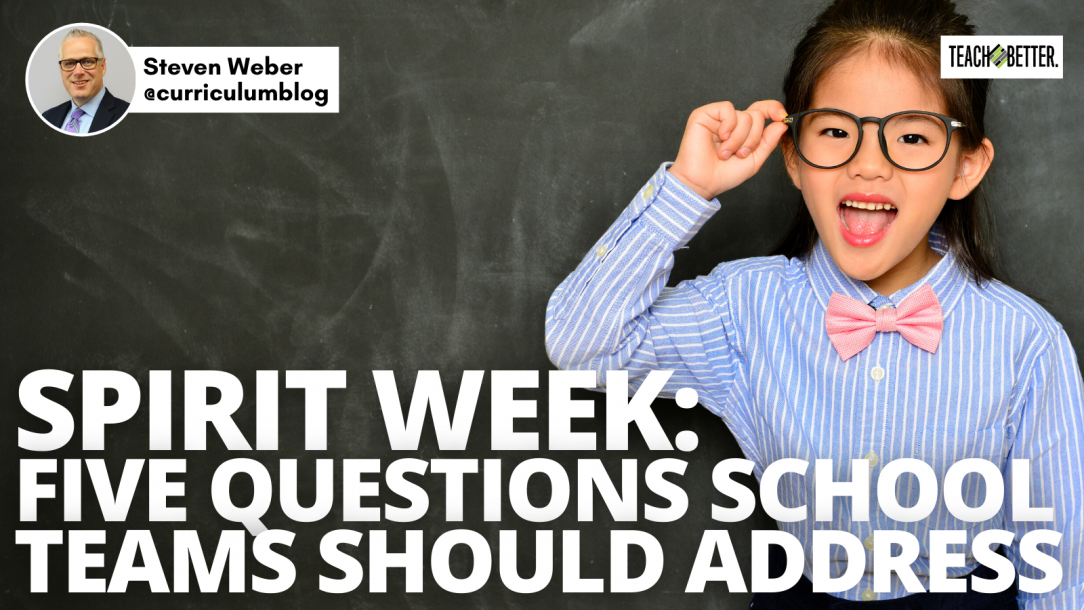TL;DR:
- Spirit Week can have good intentions, but it is important to make all students feel included each day.
- Considerations are offered for the following Spirit Days: Beach Day, College Spirit Day, Disney Day, Fancy Friday, Jersey Day, School T-Shirt Day, and Tacky Christmas Sweater Day.
- Make sure you school’s theme week aligns to your school district’s mission statement.
Spirit Week is a fun way to encourage school spirit, a positive culture, and unity among students. While these may be the intended goals of Spirit Week, some students may feel excluded during these annual events. “The unwritten tablet of social expectations found in a culture influences almost everything that happens. The culture influences and shapes the ways teachers, students, and administrators think, feel, and act” (Peterson & Deal, 2002, p. 18).
How can Spirit Week exclude some students, while making it a week of fun and positive memories for others? Over the years, Spirit week has been part of Homecoming, Red Ribbon Week, Read Across America Week, and the annual PTO Fundraiser Drive. By examining Spirit Week, teachers, staff, and families can determine if students feel empowered or embarrassed. There is no need to remove ‘fun’ from school. However, a K-12 experience should focus on all students, rather than those who can afford a costume for the daily theme(s).
By examining Spirit Week, teachers, staff, and families can determine if students feel empowered or embarrassed. Click To TweetInclusive vs. Exclusive
There are multiple ways to celebrate school spirit and to encourage students to feel like part of the school community. The examples below highlight some considerations when planning your next Spirit Week.
Spirit Week: Beach Day
Who wouldn’t enjoy Beach Day? Students could wear swim trunks, carry a beach ball, or wear goggles. If you live near a beach, it will become evident which students have actually visited the beach. Some students will have a beach chair, designer sandals, a boogie board, and a T-shirt with the name of the beach where their family spends their annual vacation.
While Beach Day sounds student-friendly, there may be several students in each class who are reminded of their economic status and the difference between their outfits and those who have actually experienced life at a beach house or a week in the sand.
Spirit Week: College Spirit Day
College and Career Readiness Day often encourages students to wear their favorite college T-shirt or hoodie. The assumption is that every student has a favorite team or can buy a sports T-shirt. Some families are season ticket holders and have the team’s latest shirt. Students may come to school with an autographed T-shirt or the team’s latest apparel.
Some students may wear the T-shirt from where their parents attended college, while other students will become first-generation college students. College Spirit Day seems like an easy option for students, but the reality is that every student does not own an officially licensed college (team) shirt or hat.
Spirit Week: Disney Day
Who doesn’t love dressing like a Disney princess, character, or wearing their favorite theme park shirt? Disney Day is a student favorite for most. School staff should use caution when planning Disney Day, because it can easily sort students into two groups: those who can afford to go to Disney World and those who cannot.
When students wear the official Disney T-shirts, Mouseketeer ears, and other items purchased from their recent vacation, it can be challenging for students to feel included. Inevitably, students will ask one another, “Have you ever been to Disney?” The question goes without asking because one could observe what each person is wearing to determine who has been to the theme park.
Children love Disney movies and one could argue that a Disney T-shirt can be purchased on Amazon or at the local mall. The reality is that some families cannot afford a Disney T-shirt or hat in order to help their child feel like they are part of the school community.
Spirit Week: Fancy Friday
When students wear their nicest clothes, interview outfit, or “Sunday Best,” it separates students by socioeconomic status. Most school staff do not mean to hurt students or create a feeling of exclusion, but Fancy Friday is a reminder to several students that they don’t have fancy clothes.
“Inequitable opportunities, privileges, and life experiences based on economic class deeply affect young children’s lives” (Derman-Sparks & Edwards, 2020). What is the psychological impact on a child when he/she realizes that her fanciest outfit is her older sibling’s hand-me-down(s)?
Spirit Week: Jersey Day
Jersey Day is similar to College Spirit Day, with one distinct difference. College Spirit Day can be accomplished with a T-shirt, face paint, necklace, or by wearing a school’s colors. Jersey Day requires students to either wear an athlete’s jersey or one of their own jerseys. Some NFL, NBA, and college sports jerseys may cost between $50 – $200. Retro jerseys may even cost more. This is not the type of thing a parent can go out and purchase the night before Spirit Week begins.
One issue with students wearing their own jersey is that some students don’t play sports, while other students may not be able to afford AAU or rec league sports. Jersey Day may be the most expensive Spirit Day option and thus it creates a spirit of haves versus have nots.
Spirit Week: School T-Shirt Day
What could possibly go wrong with School T-Shirt Day? Some elementary schools have school Spirit Day every Friday. If a school T-shirt ranges from $10-$20, some students may not be able to afford a school T-shirt. One way to avoid this dilemma is to give every student a T-shirt at least once a year (i.e. field trip, class program, field day, tie-dye shirts, or 100 days of school).
If every student owns a school T-shirt, then this may be the most equitable Spirit Day. Most students have school pride and school spirit. The question to ask is, “Do all students own a school T-shirt?”
Spirit Week: Tacky Christmas Sweater
The Tacky Christmas Sweater theme is fun and lighthearted. Most middle school and high school students enjoy this themed day. It should be noted that not all families celebrate Christmas. By requiring students to wear a Christmas sweater, you may be challenging a family’s beliefs or making some students feel uncomfortable.
Some teachers may say, “Anyone can go to the thrift store and purchase a tacky sweater.” Is it realistic that every family in your class could purchase a $5-$10 tacky sweater for Spirit Day? In addition to purchasing a tacky sweater, some families may be offended when your idea of “tacky” aligns with their current wardrobe. This seems like a harmless theme, but there are many implications for students and they aren’t all positive.
Spirit Week: Five Questions School Teams Should Address
- Does this Spirit Day theme have the potential to exclude individuals or groups?
- Does this theme create financial hardship for families?
- Which students will benefit the most from this theme and which students will feel embarrassed or excluded?
- Is this theme focused on the majority culture or does it include all students?
- What are our measurable goals around equity and inclusion?
Mission Statements
This is a sample mission statement (similar to the mission statement in most school districts).
By respecting each person’s unique identity, perspective, and learning style, we create a stronger community. We honor differences including races and cultures, genders and sexualities, abilities and aspirations, identities and affiliations, socioeconomics and worldviews. Embracing diversity prepares our students to thrive in an increasingly complex global community.
Does your school’s theme week align with your school district’s mission statement?
About Steven Weber
Dr. Steven Weber is the Associate Superintendent for Teaching and Learning with Fayetteville Public Schools (AR). His areas of research include curriculum design, formative assessment, professional learning, and school leadership.




